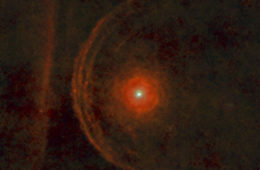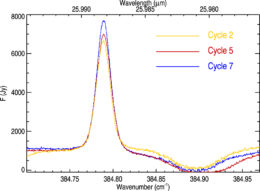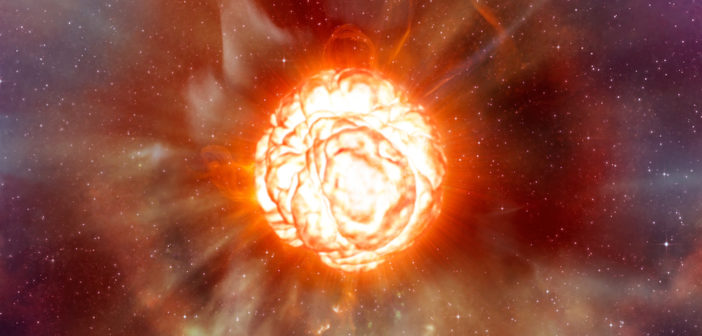
This plot of V-band brightness shows Betelgeuse’s regular ~420-day pulsations, as well as the unprecedented dip in recent months. Red filled circles show the times of the three SOFIA/EXES observations compared in this study. [Harper et al. 2020]
A Dramatic Decline
In October 2019, Betelgeuse — identifiable as the bright, massive red supergiant lying at the left shoulder of the constellation Orion — began declining in brightness. By February 2020, it had dimmed to less than 40% of its average luminosity, leading some to speculate that this star might be preparing to end its life as a dramatic supernova.
But Betelgeuse doesn’t appear to be going anywhere just yet. In February 2020, the star stopped dimming and started to climb in brightness again — and yet we still don’t know what caused its remarkable drop.

Betelgeuse, shown here in an infrared image from the Herschel Space Observatory, is a luminous red supergiant star located about 700 light-years away. [ESA/Herschel/PACS/L. Decin et al.]
The Role of Red Supergiants
Why do we want to understand what’s happening with Betelgeuse? Red supergiants like this one represent a late evolutionary stage of massive stars. In this phase, strong winds flow off of the star, carrying away mass and populating the surrounding area with enriched stellar material.
But despite the important role these stars play in shaping galaxies and populating them with elements, the red supergiant stage is poorly understood, and there’s a lot we don’t know about the atmosphere, outflows, and timing of a star’s behavior during this phase. By tracking the evolution of Betelgeuse, a conveniently bright and nearby laboratory, we can further explore these processes.
A Telescope in Flight
Scientists have proposed two main explanations for Betelgeuse’s recent dimming: either it’s an intrinsic cooling of the star’s photosphere, or Betelgeuse has thrown off dust that’s now lying between it and us, blocking some of its light.
Because infrared observations will be critical to exploring these options, NASA-DLR’s Stratospheric Observatory for Infrared Astronomy (SOFIA) planned an extensive campaign to look at Betelgeuse and its environment.SOFIA consists a telescope mounted on an airplane that flies above 99% of the Earth’s infrared-blocking atmosphere. Observations of Betelgeuse were planned throughout winter/spring 2020 with all the instruments scheduled to fly on SOFIA. Now the first of these results, from the Echelon Cross-Echelle Spectrograph (EXES) instrument, have been published in a new study led by Graham Harper (University of Colorado Boulder).
Going with the Flow
Harper and collaborators explored Betelgeuse’s circumstellar envelope, the sphere of stellar material that flows off of and surrounds the star. In particular, the SOFIA/EXES observations are of two gas emission lines: singly ionized iron, and neutral sulfur. The authors compare observations of these lines from February 2020, when Betelgeuse was at its dimmest, to observations from 2015 and 2017, when Betelgeuse was at its normal brightness.

SOFIA/EXES observations of the ionized iron emission line around Betelgeuse during Cycle 2 (2015; yellow), Cycle 5 (2017; red) and Cycle 7 (February 2020; blue). [Harper et al. 2020]
These results are one more piece in the puzzle of Betelgeuse’s strange behavior. And with additional observations from other SOFIA instruments soon to be analyzed, we can anticipate more news to come!
Citation
“SOFIA-EXES Observations of Betelgeuse during the Great Dimming of 2019/2020,” Graham M. Harper et al 2020 ApJL 893 L23. doi:10.3847/2041-8213/ab84e6


3 Comments
Pingback: From AAS NOVA: “Observations of Betelgeuse’s Dimming from the Stratosphere” | sciencesprings
Pingback: Featured Image: Forming Betelgeuse from a Stellar Merger
Pingback: Beteigeuzes „Großes Verblassen“: fünf Papers … | Skyweek Zwei Punkt Null